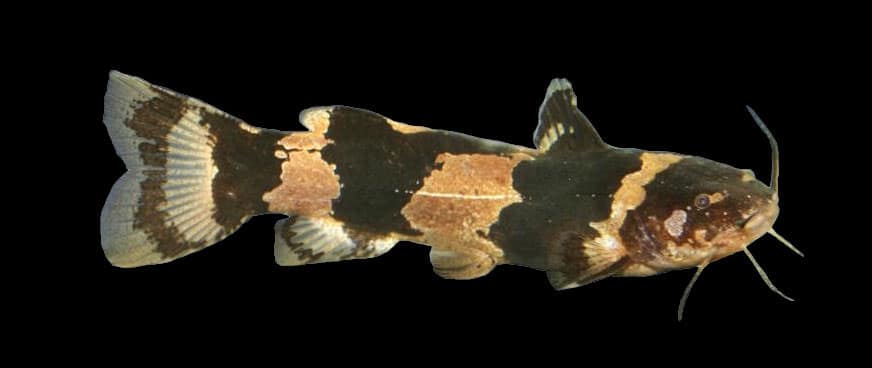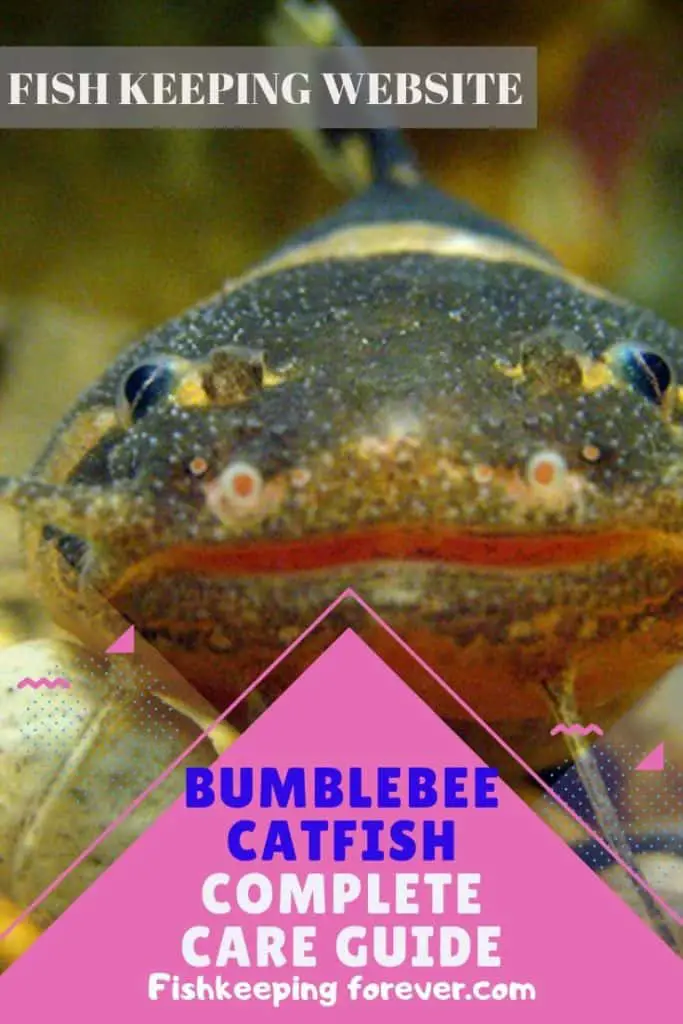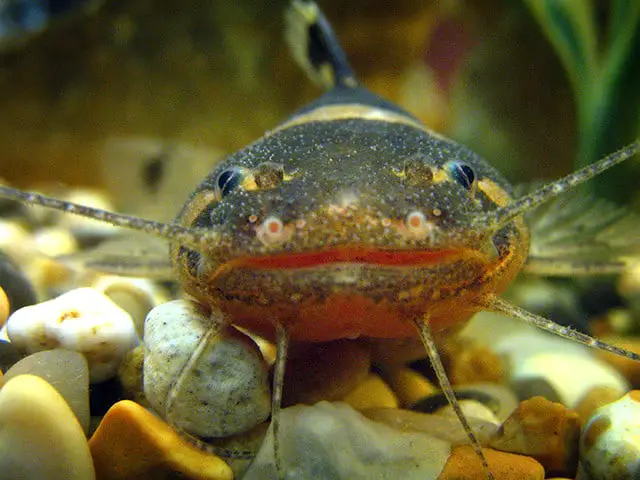The Bumblebee Catfish (Microglanis iheringi) is a small catfish with a striking color pattern which is also known as the South American Bumblebee Catfish. These freshwater tropical fish are native to Venezuela.
They can be found in the wild living in strong flowing waters in and around the Amazon Basin and are native to Peru and Colombia in addition to Venezuela and many other areas of northern South America.
Table of Contents
Introduction
The Bumblebee Catfish is primarily a nocturnal catfish that will rarely come out during the day unless it’s in search of food. I have seen and heard mixed opinions on this. Mine would hide under a piece of driftwood but would often come out and swim up the side of the glass in search of food.
Other tropical fish keepers have reported hardly ever seeing their Bumblebee Catfish. It depends on how densely planted your aquarium is. If you have a natural look aquarium with plenty of rocks and caves for them to hide in then you’ll probably not see them a lot.
Their natural instinct is to find a shaded or dark place to hide throughout the day and come out to play at night.
If you’d like to know what we feed our South American Bumblebee catfish click here ?

Don’t let this put you off buying one of these special little catfish. Their color, patterns and behaviors when they are out in the open make up for the lack of time you see them.
As their name states their orange and black stripes make them one of the most interesting to look at catfish.
Bumblebee Catfish are not particularly aggressive but can be somewhat predatory.
Species Profile
There are two types of Bumblebee Catfish, the South American Bumblebee Catfish, and the Asian type. These may look very similar but have totally different behaviors.
The South American Bumblebee Catfish can easily be identified by a spot at the base of the caudal fin.
| Common Names | South American Bumblebee Catfish, Bumblebee Catfish |
| Scientific Name | Microglanis iheringi |
| Family | Pseudopimelodidae |
| Size | 2-3" Max |
| pH | 6.5-7.5 |
| Water Temperature | 21-25°C (70-77°F) |
| Lifespan | 3-5 Years |
| Tank Level | Bottom |
| Temperament | Peaceful- With caution. Will eat small fish such as neons |
| Minimum Tank Size | 20-25 Gallons |
| Diet | Carnivores |
| Suitable Foods | bloodworms, Flake, Sinking Pellets, Live foods, Frozen foods, Meaty foods finely chopped |
| Care Level | Easy |
| Water Hardness | 8-12 dGH |
| Lighting | Moderate to Low |
| Cost | $5-$8 |
| Recommended First Fish | Yes |
| Community Tank Suitable | Yes-With caution they will eat small fish |
Systematic Position
- Phylum: Chordata
- Sub-phylum: Vertebrata
- Class: Actinopterygii
- Order: Siluriformes
- Family: Pseudopimelodidae
- Genus: Microglanis
- Species: Microglanis iheringit
This Catfish was defined by Eigenmann in 1912. It has since become a popular catfish for tropical fish keepers to own due to its colors and striking patterns. It only grows to a maximum of 3″ which makes them an attractive purchase for aquarists with a smaller aquarium.

Body Shape And Looks
These catfish have the very common shaped catfish body when compared to many catfish from South America.
They have an elongated body with a head that is flattened, with well-marked lateral lines. With a wide mouth and barbells that can reach the spines on its pectoral fins in some species.
Black and yellow banding make for a striking appearance. Their dorsal fins are strong and well developed.
Their wide mouth makes them perfect for eating small fish and scavenging on the bottom of the substrate.

What Size Tank Do they Need?
The substrate is very important for these catfish. A soft and small gravel base is preferred as they scavenge in the gravel for leftover foods. Large sharp gravel has been known to damage their mouths and cause infection.
A suitable aquarium size is 20-25 Gallons as a minimum. These fish are small in comparison to some other catfish but still need a suitably sized aquarium for them to thrive.
Provide the water conditions below:
- pH of 6.5-7.5
- 21-25°C (70-77°F)
- Soft acidic Water
- Medium Flow strength water
- 25% Water change weekly
- 8-12 dGH
Decoration should match their natural environment. Provide plenty of shaded areas for them to make their home. Driftwood is a great choice for many catfish. It helps maintain soft acidic water conditions at the same time as providing suitable hiding places.
Live plants will not only help make your aquarium look amazing but it will also help your Catfish feel at home.
Use rocks and stones to make caves and suitable hiding places. However, ensure you glue the rocks in place or together as these catfish love to move the substrate around in search of food. This has, on rare occasions, caused the rocks to fall and harm the catfish.

We use aquarium safe silicone sealer to make and form lovely caves and hiding places. If you’re unsure which glue is safe and nontoxic then read our article here.
It’s important to ensure a medium flow of water that is well oxygenated is provided. If you’re unsure how much oxygen is in your aquarium then read our guide on the subject.
Diet
In the wild, this carnivorous fish feeds on insects and their larvae along with small meaty matter laying on the river bed.
In captivity, these fish will happily accept a wide variety of food including live and freeze-dried foods such as Bloodworms and Daphnia.
Below is a guide for feeding your Bumblebee Catfish:
| Food | How Often | How Much |
|---|---|---|
| Flake Food | 3 Times a day | Enough to consume in 90 Seconds |
| Pellets | 3 Times a week | 1-2 Mini Pellets Per Fish |
| Bloodworms - live | 2 Times a week | 1/4 Teaspoon of worms per fish |
| Bloodworm - Freeze Dried | 2 Times a week | Small Pinch |
| Algae Wafers / tablets | 2 Times a week | 1 Tablet or wafer per 10 fish |
| Brine Shrimp - Live | Once a week | 1-2 Brine shrimp per fish |
| Other supplement foods or Vegatables | 2 Times per week | Enough to consume in 90 Seconds |
Ensuring your catfish receive the correct foods is your responsibility as a tropical fish keeper. We always recommend you only feed your fish the highest quality food available.
If you’re unsure which foods to feed your tropical fish in general then read our fish food guide.
However, if it’s your beloved catfish, like these amazing South American Bumblebee Catfish, then read our catfish fish food guide here.
Always remember to feed your fish little, but often. Never overfeed your fish as this will cause your water conditions to be negatively affected.
If this happens you will need to perform a partial water change. 25% is recommended with no more than 50% as this can cause shock to your fish.
Read here and learn how to perform a fast and possible lifesaving water change.
Breeding Guide
It has to be said that these fish are very difficult to breed in captivity and the majority of fish found for sale in your local aquatic store or pet store are farm bred in Asia.
The key to breeding these catfish is the conditioning of them ready for mating. Here is our method of conditioning these fish ready to breed.
- Place these fish in a quiet aquarium
- Reduce the lighting
- Feed them on live foods such as daphnia, brine shrimp and Bloodworm
- Raise the temperature to 75-78 F
- Provide caves and tunnels (We use aquarium safe plastic pipes)
- After a few weeks in these conditions perform a large water change
- This will encourage spawning
- The female will lay her eggs in the tube or cave
- The male guards the eggs for 5-10 days until they hatch
Cases of breeding these Catfish in captivity and in the home aquarists aquarium is very rare.
These breeding tips and conditioning guidelines are from experienced fish farms and have been successfully used in the trade to breed these fish.
What To Look Out For When Buying one
When buying any tropical fish you should look out for some tell-tail signs and these catfish are no different.
We always recommend buying from a reputable dealer or pet store. Private breeders and sellers are one of my favorite places to purchase tropical fish from. Simply because they can give you all the background on the fish in question and don’t stock as many species, therefore, they take extra special care of their fish.
Below are some of the tell-tail signs and things to watch out for when buying any catfish. Also, some simple tips when choosing the right fish.
- Ask to see them feeding
- If they’re under rocks or driftwood ask for them to be removed so you can see the fish clearer.
- Ask when the fish was imported and from where
- Check the water conditions they are kept in are similar to yours
- Ask how the fish was acclimated to the store’s aquarium
- Check for signs of damage to their body and fins
- Look for signs of disease
- Erratic swimming
- Unbalanced body or swimming motion
- Abnormal behavior
- Bulging eyes

Bumblebee Catfish Cost
Some of the reasons tropical fish differ in price is due to the region they come from, farm-bred or wild-caught as well as their size.
They only grow to 3 inches, so size isn’t normally the biggest price factor.
Condition and quality can and will affect the price they charge for the fish, as you would expect.
Wild-caught catfish always command a higher price but also come with the bigger risk. These fish don’t always acclimatize to aquarium life well. Farm bred species are always cheaper and more hardy as they are already used to your water conditions.
Below is the average cost of a South American Bumblebee Catfish:
| Region | Size | Cost |
|---|---|---|
| Wild Caught | 1-1.5" | $5.99 |
| Farm Bred | 1-1.5" | $3.99 |
| Wild Caught | 2-3" | $6.99 |
| Farm Bred | 2-3" | $4.99 |
| Wild Caught | Adult 3" | $8 |
| Farm Bred | Adult 3" | $6-$7 |
Lifespan
In the wild, the average lifespan of a South American Bumblebee Catfish is 5-6 Years.
In captivity, the life span of a bumblebee catfish is 4-5 years maximum
Suitable Tank Mates For South American Bumblebee Catfish
Bumblebee Catfish are peaceful fish but as with many other catfish have a predatory nature. They will eat small fish like Neon Tetras and Zebra Danios.
They are suitable for a mixed community tropical fish tank with caution. Don’t put them with smaller fish or they will attack and eat them at night. They are nocturnal fish that will hunt for food and live food at night.
Suitable fish are Angelfish, Gouramis, Platies and Swordtails, Catfish, some Barbs and many other larger and peaceful tropical fish.
F.A.Q
- How big do they get? 3″ maximum
- How long do they live 3-5 years
- Can they be housed in a community aquarium? Yes
- What do they eat? Flake and live foods, pellets
- Where do Bumblebee Catfish come from? South America
- Are bumblebee catfish nocturnal? Yes
- Can bumblebee catfish live with other catfish? Yes
- Will they eat smaller fish? Yes, anything under 1″ is at risk
- Can they live with Betta Fish? Yes
- Can you breed Bumblebee Catfish? Yes, but they are very difficult to breed
- How much do Bumblebee Catfish cost? Aprox $6-$8
- Do Bumblebee Catfish eat snails? It’s not their favorite diet but they can
Conclusion: South American Bumblebee Catfish
We hope we have you interested in buying a South American Bumblebee catfish. It’s fair to say they won’t be the most visible fish in your aquarium all day long but when they do make an appearance they steal the show.
I would recommend them to anyone with a mixed tropical fish tank to add another dimension to the bottom of the aquarium.
They will help clear some of the garbage from the bottom of the substrate and will help clean the aquarium floor. But that’s not why you should buy one.
You should buy one because they look incredible and add drama and interest to the base of your fish tank. Place a hiding place at the front of your aquarium and see them make their home in it facing forwards.
That way you get to see their face and eyes light up at night or as the lights go dim.
- Silver Arowana: Complete, Care, Breeding, Feeding Guide
- Rainbow Shark: Diet | Size | Breeding | Cost
- Tiger Barb Fish: Diet | Breeding | Size | Water Conditions
- Jack Dempsey: Diet | Size | Breeding | Lifespan | Sexing | Care Guide
- How Are GloFish Made? Facts & F.A.Q
Image credit for the feature image @con ryan-Flickr

I have been working in the tropical fish industry for over 30 years now and I’m still learning. Everyday is a school day in this hobby. In my spare time I play golf very badly!


